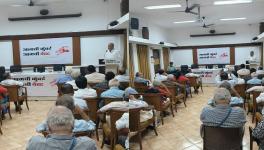NPA Disease - Privatisation is Not the Cure: Thomas Franco
Thomas Franco, general secretary of AIBOC (All India Bank Officers Confederation), speaking to Newsclick said that the government can not place the blame of the NPAs on the public sector banks. The banks followed the guidelines from the RBI and government in disbursing loans to the infrastructure and other sectors which have turned NPAs. He said that RBI should place limits on the amount of loans bank can disburse to large corporates. According Mr. Franco, it is time to reorient bank lending towards farmers, small entrepreneurs and other neglected sections. He also said that privatisation of public sector banks, will take the country back to the days when farmers and common people were denied loans by the private banks.
Thumbnail Image Courtesy: Indian Express
Rough Transcript:
Srujana: Hello and welcome to Newsclick. As you know banking sector has been recently much in news; be it demonetization or the NPAs or the whole debate about privatization. Today we have with us in our studio Mr. Thomas Franco, General Secretary of AIBOC, All India Bank Officers Confederation.
Welcome to Newsclick, Mr. Thomas Franco. So let us begin with demonetization which, maybe not a fresh topic but is still showing its impact. For example, the government made lots of claims during demonetization. It said that 3 – 4 lakhs of black money will be exposed and it can be spent on people. But so far the government has not come out with any accounts, it hasn’t told us how much of the money has come back and how much of the money has revealed to be black money. So what do you think of this whole thing? What do you think of the figures that are not being shown, what do you think of the impact of demonetization on the economy?
Thomas Franco: First of all, as you rightly pointed out, there were projections saying that at least 3-4 lakh crores will not come back and that will become the money which can be used or we can transfer it to the government of India and people were even talking about giving a credit of Rs 15,000 for every jan dhan account which is 28 Crore accounts. Even today, Reserve Bank of India is not in the position to tell us the data. I don’t know where the difficulty is for them. It is so unfortunate that the Reserve Bank governor tells a Parliament committee that we’re still counting the notes. We in the bank, we know what has happened. We have already collected; we have given the report on the 31st of December. RBI has the data on how much money has been collected. So ultimately what is going to come back as black money or tax income is costly number. Yes there has been improvement in the income tax collection; more people have filed returns and, more people have paid tax. It can be because of the natural growth also but to some extent tax collection has slightly improved. Counterfeit currency – people have started printing fake 2,000 rupee notes, it is coming to the banks. Terrorism has increased; nowhere has it stopped. Corruption does not stop in one place in one day; the root cause of corruption if it is not arrested. And in my assumption, the root cause of the corruption is the large corporates who bribe the people at the top. Finally if we look at the balance sheet of demonetisation, we don’t see that any of the objectives have been achieved. Even in the longer run, it may not really help the economy.
Srujana: In the banking sector, there seems to be a crisis at the moment. The NPAs of the whole banking sector probably stand at Rs. 7.2 Lakh Crore. And out of which the NPAs of public sectors are the majority. About 5 Lakh Crores of the NPAs actually belong to the public sector. So how did these NPAs accumulate because it’s a huge amount and how is it going to affect the banking sector, particularly the public sector banks?
Thomas: Even today’s public sector banks are dealing with 72% of the nonprofit advances. So naturally the NPA in public sector will be more than private sector when you compare the amount. Recently reports have come out that ICICI, Axis, Yes Bank, they have hidden their NPAs. To show that they are getting more profit, they have been hiding it and now investigations are going on. If you see the data after nationalization, up to 1991-92, banks were giving quite a number of small loans, medium sized loans. So even if some of the accounts become nonperforming assets, it was not affecting the balance sheet much. Earlier we had a norm of RBI called, The Credit Authorization Scheme in which even a loan above 1 crore, you had to get an approval of Reserve Bank of India; all this was removed. So there was no question of having even a maximum limit to a borrower or a corporate. So this has led to a situation today where only 0.5% of the Loan scheme as on March 31st, 2015 has gone to small people-which are less than 25,000 loans. Naturally, more loans have been given to few individuals, which are huge loans. As per the data published by Business World, Reliance group has an outstanding – in all companies taken together – it comes to more than 1.7 Lakh Crores. Now reliance has two groups – Mukesh and Anil Ambani’s group. Anil Ambani’s group was to be declared as NPA; there the banks, RBI, everybody is taking different stand, that you restructure it. Reliance defense, which is an NPA has been converted into a long time finance, 20 years repayment so that it is not declared as NPA and he can compete in the defense deals. Similarly the reliance communications, there is more than 40,000 crores NPA. So the norms which are there, it is not applied properly to all. Favoritism is visible. Parliament’s standing committee’s recommendations have not been implemented. What is the role of RBI director in the board? What was the role of the finance ministry’s representatives in the board of these banks, what action has been taken against them, what actions have been taken against the board of directors and the MDs who took these decisions? And why can’t you convert this infrastructure loan to a long term loan and give it to Industrial Finance Corporation?
We have done an analysis. Say they call 10 banks as weak banks and they ask us to sign on memorandum of understanding to prepare a turnaround plan. All these banks, it is all consorting and if we address this, 20 – 30 corporate advances will not recover additional capital and NPA will come down. Parliament has themselves said that 86% of the NPA is to the corporates. A firm itself has said that it has just 20 – 30 accounts. It’s in the hands of the government to take a decision. They are talking about people are not able to take decisions because they are afraid of CBI enquiry, they are afraid of vigilance enquiry. Our question is, what is wrong in the vigilance enquiry or CBI enquiry against people like Anjali Bhargava, who was responsible for giving lot of loans to corporates in a short time frame, in United Bank of India. Our Mr. Yogesh Agarwal, in IDBI he violated all the norms and gave money to Kingfisher Airlines when Kingfisher was already declared as an NPA. What is wrong in investigating? Other than that we don’t come across so many investigations against senior executives. The investigations are all at the lower level of people who give small loans. These big loans are handled by the EDs, the committees which are sitting at the top. So if the government and RBI are really serious; one, they have to implement these recommendations of the Parliamentary Standing Committee. Two, they have to put a ceiling on credit limit to a corporate. And these groups like Ambanis, Adanis who are getting large loans at very cheap interest rates and are not able to repay the loans. The reality is that if some of these loans are declared as NPA, the banks themselves will collapse. Now if Ambani group’s assets if you declare as NPA, their entire banking sector which is financed through consortium advances, the bank itself will become non-performing. So this ceiling has to be brought in and the credit orientation has to change. We have to re-orient the lending policies to help the larger majority of the country. The farmers, you go and talk to them, they say we are not getting adequate and specially small and marginal farmers. Traders are saying that they don’t get enough credit. Women are saying that they are not even getting loan under the SAG landing. Students are saying that they are not getting educational loan. Entrepreneurs are saying that they are not getting cheap credit. So this dichotomy has to be addressed. Once you re-evolve the landing policies and lend to larger number of people, and smaller advances, naturally the NPA will come down. And immediate things are needed to get back what has been given to these large corporates.
There is no way to say that the bankers have done something wrong. They have perfectly followed the policies of the government and RBI.
Srujana: In the background of these NPAs, there is a lot of talk about privatisation. RBI’s deputy governor Viral Acharya has at times commented that the only way out is re-privatisation of some of the banks and divestment of staking some of the bigger banks. Same with Governor Urjit Patel, at certain points they’ve indicated that privatisation needs to be done. And again, finance minister Arun Jaitely has also said that privatisation of the banks is called for, right now. But how does it impact the economy and the credit outflow to lot of sectors that depend on public sector banks?
Thomas: The Prime Minister in Economic Conclave made a statement very clearly that, government has no business being in business. He also made a statement that public sector was warned to die. The Chief Economic Advisor to the government says that nationalization was a blunder. The RBI governor goes abroad and makes a speech in which he says that some of these banks will not survive and we should allow it to die. Now we have seen during the 2008 financial crisis that Indian banking system was not affected much because of the public sector banks; Y.V Reddy has been appreciated. Now if you see the achievements of the public sector banks, which people are not talking about; between 1969 to 1991, tremendous achievement has been done as per the goals given to them. And you should also recollect that before 1969, there were lot of private sector banks which could not cater to the economy. The purpose of nationalization was not creating profit for the banks and giving to the government; it was a social objective of reaching credit to the common man, reaching banking services to the rural interiors. And enough of studies are there to show that all these goals have been achieved, day by day services were improving. But then suddenly we decided to go on a different track. We had Narasimhum committee, then we had Anil Khandelwal committee, we had Raghuram Rajan committee, which all started talking about privatizing the public sector. The corporates were looking at it like this; earlier we did not have that kind of expertise to run banks, today public sector banks are doing well, so let us start loaning them; so we don’t have to go and borrow, we can use the same money for our own industries.
That is exactly what was happening before 1969, which has come out in different studies; R.K. Hazare report is there, All India Rural Credit Server report is there.
Out of the 28 Crore Jan Dhan accounts opened, 95% of the accounts are opened by the public sector banks, not the private sector banks; whereas private sector banks control 28% of the banking business. Will they give this loan called the Mudra loan or the Stand up India loan or Start up India loan, agriculture loan, education loan? They will give for corporates, they will move for education loan for going abroad where they can take security. So, the access to credit will become a big question when privatisation takes place. The time has come when we should bring people of the country; the farmers, the traders, the students, the youth, the women, the entrepreneurs, small manufacturers, tiny and micro enterprises, they should come together and demand that we require these public sector banks to be in public. Because if privatisation takes place, all of them are going to be affected. Will ICICI, Axis, Standard Charter, Citi Bank, go and lend to these people who are marginalized? They will never do that. Privatisation is not the solution, more of public services, more of public sector banks are the need of the hour.
Srujana: Thank you Mr. Franco, thank you for joining us. Thank you for watching Newsclick.
Disclaimer: Please note that transcripts for Newsclick are typed from a recording of the program. Newsclick cannot guarantee their complete accuracy.
Get the latest reports & analysis with people's perspective on Protests, movements & deep analytical videos, discussions of the current affairs in your Telegram app. Subscribe to NewsClick's Telegram channel & get Real-Time updates on stories, as they get published on our website.
























